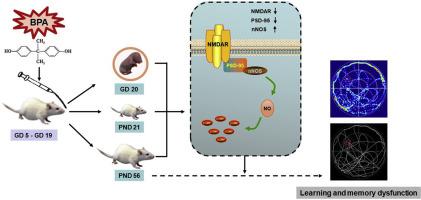Environmental Pollution ( IF 7.6 ) Pub Date : 2020-06-29 , DOI: 10.1016/j.envpol.2020.115055 Haiyang Yu 1 , Lin Ma 1 , Di Liu 1 , Yu Wang 1 , Xiucong Pei 1 , Zhiwen Duan 1 , Mingyue Ma 1 , Yumin Zhang 1

|
Bisphenol A (BPA), can lead to learning and memory impairment, but the underlying mechanism is poorly understood. Researchers have indicated that the N-methyl-D-aspartate receptor (NMDAR)/postsynaptic density protein 95 (PSD-95)/neuronal nitric oxide synthase (nNOS)-nitric oxide (NO)-cyclic guanosine monophosphate (cGMP) pathway greatly contributes to learning and memory process. Pregnant rats were exposed to 0, 0.05, 0.5, 5 and 50 mg/kg/day BPA via oral gavage from gestational day (GD) 5 to GD 19. Morris water maze, transmission electron microscope, western blot, real time PCR, biochemical analysis and ELISA were used to analyze the changes in behavior, synaptic ultrastructure, protein and gene expression of NMDAR, PSD-95, nNOS, together with nNOS activity, NO (Nitrate reductase method) and cGMP levels of the rat pups at different growth stages. Results of this research displayed that exposure to 0.5 mg/kg/day BPA could damage the spatial learning ability of rats at postnatal day (PND) 56. However, spatial memory ability could be affected by exposure to BPA at doses up to 5 mg/kg/day. Moreover, the thickness of the postsynaptic density decreased after exposure to BPA at doses of 5 and 50 mg/kg/day. Levels of NR1, NR2A, PSD-95 protein and mRNA were downregulated to some extent after exposure to BPA, whereas the expression of NR2B increased at GD 20 but decreased at PND 21 and 56. Contrarily, the nNOS expression along with the enzyme activity were promoted after exposure to BPA. Meanwhile, the NO and cGMP levels were suppressed at GD 20 but promoted at PND 21 and 56. In conclusion, these results demonstrated that NMDAR/PSD-95/nNOS–NO–cGMP pathway could be affected by embryonic exposure to BPA, which may involve in the spatial learning and memory dysfunction of rats in later life.
中文翻译:

NMDAR / PSD-95 / nNOS-NO-cGMP途径参与胚胎暴露于BPA诱导的大鼠学习和记忆功能障碍。
双酚A(BPA)可能会导致学习和记忆障碍,但基本机制尚不清楚。研究人员表明,N-甲基-D-天冬氨酸受体(NMDAR)/突触后密度蛋白95(PSD-95)/神经元一氧化氮合酶(nNOS)-一氧化氮(NO)-环鸟苷单磷酸(cGMP)通路做出了巨大贡献学习和记忆过程。从妊娠第5天到GD 19,通过口服管饲法将妊娠大鼠暴露于0、0.05、0.5、5和50 mg / kg / day BPA,Morris水迷宫,透射电子显微镜,western印迹,实时PCR,生化试剂分析和酶联免疫吸附分析用于分析不同生长阶段大鼠幼崽的行为,突触超微结构,蛋白质和基因表达的变化,以及NMDA活性,PSD-95,nNOS,nNOS活性,NO(硝酸还原酶法)和cGMP水平。这项研究的结果表明,暴露于0.5 mg / kg / day的BPA可能会损害大鼠在出生后一天(PND)的空间学习能力56。但是,暴露于5 mg / kg的BPA可能会影响空间记忆能力公斤/天。而且,在以5和50mg / kg /天的剂量暴露于BPA后,突触后密度的厚度降低。暴露于BPA后,NR1,NR2A,PSD-95蛋白和mRNA的表达水平有所下调,而GD2 20时NR2B的表达增加,而PND 21和56时则降低。接触双酚A后提升。同时,NO和cGMP水平在GD 20时受到抑制,而在PND 21和56时升高。











































 京公网安备 11010802027423号
京公网安备 11010802027423号